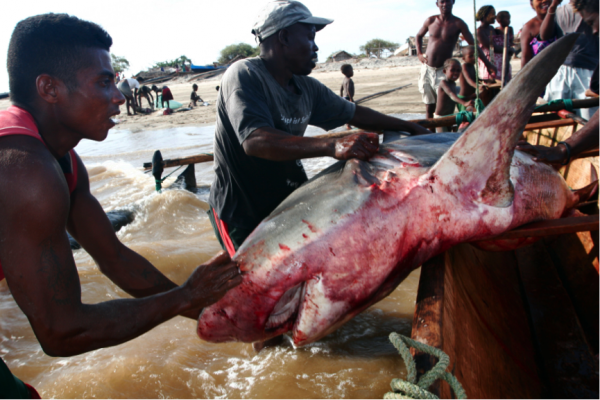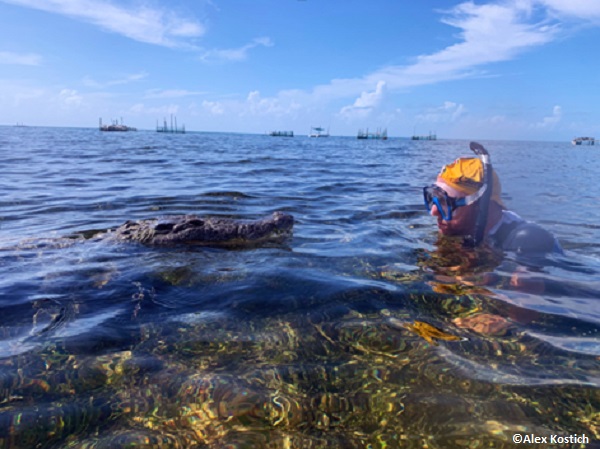As a proud new contributor to the Ocean Views blog, I’ll be bringing you stories from myself and my colleagues at Blue Ventures about marine conservation in Madagascar and Belize. This first one comes from Garth Cripps, a senior conservation scientist with Blue Ventures in Madagascar. Here Garth tells us about a series of encounters he’s had with a Malagasy shark fin collector named Visy. Take it away Garth.
I first met Visy in Bemakoba, a village on the Tsiribihina delta, western Madagascar. Bemakoba literally means “the place of many rays.” The name resonates through the community of migrant Vezo fishermen along the west coast of Madagascar. For good reason: the shark fishing here is said to be the best.
I remember my first trip to Bemakoba in 2009 vividly: True to its name, the day we arrived there the beach was littered with rays being butchered. Shark fishermen had caught most of a shoal in a ZDZD – a nylon monofilament gillnet introduced by the German development agency GIZ in the early 1990’s. The idea had been that fishermen would target pelagic fish; but most of what is now caught in this type of net is guitar fish, juvenile sharks and many species of rays.
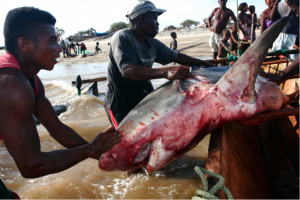
There was a thump, thump as some rays, still alive, beat their wings hopelessly against the sand. Under the harsh sun a muddy brown sea lapped over the white of upturned ray carcasses; the sand was dirty and black, in parts red with blood. The fishermen had also caught an adult bull shark using a handmade longline. Straining, they hauled it out of their outrigger sailing pirogue. It sagged in the shallow water, until the fishermen pulled it up onto the beach to where they could butcher it.
The fishermen and their families lived in reed huts scattered along the edge of this beach. They were all migrant Vezo fishermen from southwest Madagascar, and had sailed here to seek out the still good shark fishing. Visy had financed many of them, giving them seaworthy pirogues large enough to make the 500 km trip, shark fishing gear, and enough rice to eat while they were making the journey north. In return they sold their shark fins to him.
Dried shark and ray meat was piled up against Visy’s hut; next to it, fins were drying on a stick rack. Inside, large steel hooks with traces made from bicycle brake cables hung from the rafters; and in the corner there were two old rice sacks filled with dried shark fins. Some fishermen kept the remains of butchered carcasses by their huts, forming tangled heaps of shark heads, cartilaginous skeletons and tails alive with maggots. Here, day and night, the stench of rotting shark envelops you.
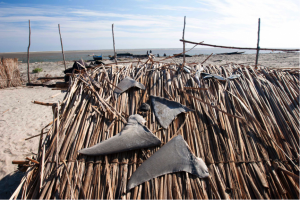
The squalor of Bemakoba belied the amount of money passing through it. At the time, Visy was buying around $30,000 U.S. worth of fins a week, sometimes more, from fishermen along this length of coast. Visy sold his fins to Chinese buyers in Antananarivo. From here they would be exported to Hong Kong, the world’s principal shark fin market. The Chinese buyers in Antananarivo fronted Visy cash, which he would repay when he sold fins to them.
Malagasy people attach no value to shark fins, but for some Chinese, shark fin soup is a prized dish, traditionally served at wedding banquets. A bowl of shark fin soup can sell for as much as $100 U.S. Strong economic growth in China over the last two decades has markedly increased the value of shark fins, driving their commercial exploitation worldwide.
Over this period, the fins of between 38 to 76 million sharks were traded in Hong Kong each year. Estimates of global shark catch are as high as 100 million a year.
Sharks are K strategists and apex predators, exhibiting low fecundity, slow growth and late maturity. This makes them particularly vulnerable to overfishing, and globally shark populations have declined by as much as 70 to 80 percent. Thirty percent of all shark and ray species are now classified as “threatened” or “near threatened” with extinction by the IUCN Redlist.
That was early 2009. Now Visy lives in the Vezo quarter of Nosy Kely, Morondava, at the end of a road that passes upmarket hotels, but then leads to a typical Vezo village of reed huts, white sand, and alleys lined with fences of mangrove poles.
He looks much thinner and older than before. He had to leave Bemakoba; armed bandits – dahalo – raided the village too many times. To escape them, the villagers would take refuge in the nearby mangrove forest. “My wife got tired of sleeping in the mangroves,” he tells me, “too many mosquitos.”
“The fishing is still good there, but it has become too dangerous and the Vezo have abandoned the village.”
Business is not good either. Prices for shark fins depend on the length of the fins and the amount of fibres or needles they have (so the species). In 2009, a Vezo fisherman could earn $125 U.S. or more for a kilogram of dry, “premier quality” shark fins, even more for guitar fish fins. The prices went higher in 2011, but then dropped by 60 percent in 2012. Smaller fins are now worth very little.
It is also increasingly rare for a Vezo to catch an adult shark. In the early 1990’s in southwest Madagascar, Visy used to catch adult sharks on reef flats only a few hundred meters offshore. Fishermen caught adult sharks daily. In the mid to late 1990s, local shark catches in southwest Madagascar dropped and Vezo began migrating northwards. In increasing numbers they went looking for remote, untouched fishing areas, going to the Barren Isles and Nosy Vao. But even in these isolated places, fishermen are only catching a few sharks a month. Some months they catch none.
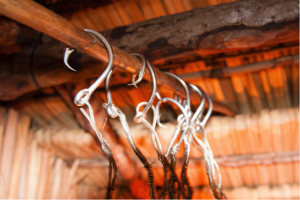
In places such as Bemakoba, fishermen begin sailing at three in the morning, setting their nets fifty kilometers offshore, and only returning late in the day. They use narrow, six-meter long outrigger sailing pirogues, and pull the nets up from 200 meters deep by hand. It is a risky and relentless life. With prices so low and catches scarce, why do they continue shark fishing?
“The Vezo only know one life – fishing. They have no choice and will continue because that is their way of life,” says Visy.
“All the Vezo need to buy is rice and materials to make fishing gear and sails. The rest they get from the sea. So even if the price of shark fins is very low, they will continue fishing for them.”
Two small boys walk into Visy’s hut, where they’ve been sent by their father to sell some fins. They are the fins of a small hammerhead shark, quite possibly Sphyrna lewini, an endangered species. Visy lies them out on the floor: the pectoral and pelvic fins here, the large dorsal here, and the caudal there. Hammerhead sharks have unusually slender bodies. Visy knows this, and from the way he places the fins, you can see where the perfectly hydrodynamic body would have fitted where now there is only grey concrete.
“Here,” Visy hands over a 5,000 Ar ($2.50 U.S.) note to one of the boys. “Bring me the change.“
I hadn’t misheard: these fins are worth 1,000 Ariary, or about 50 cents U.S. That’s the price of three small cups of rice, a simple meal for a small family.
In contrast to many shark fisheries in the world, where finning is practiced, the Vezo waste no part of the sharks they catch. They use the oil for cooking; sell the jaws to tourists; and eat the meat fresh or salt and dry it to sell later. While certain species are good to eat, shark meat often has high urea content, making it unpalatable.
Fishermen sell it dried for 800 to 1,500 Ar (about 30 to 60 cents) a kilogram. In local markets, the meat of one of nature’s most formidable predators, which has survived for 250 to 300 million years, sells for a fraction of the price of chicken. In one of the world’s poorest countries, it is often seen as a poor man’s food.
Social marketing campaigns in China, as well as the Chinese government’s ban on the dish at official banquets, are thought to be reducing the demand for shark fins. But here in Madagascar, poverty and the Vezo’s ingrained way of life mean that shark fishing will continue. The battle to protect sharks here is more one of alleviating poverty amongst traditional fishing communities.
A special thanks to our friends at Ocean Views Blog, Garth Cripps and Brian Jones, colleagues at Blue Ventures, for allowing us to post this wonderful and informative article.
Also be sure to visit Blue Ventures for exciting opportunists in volunteering.
